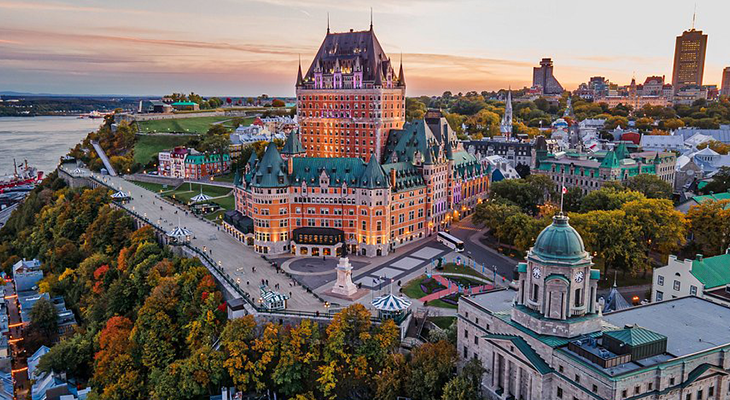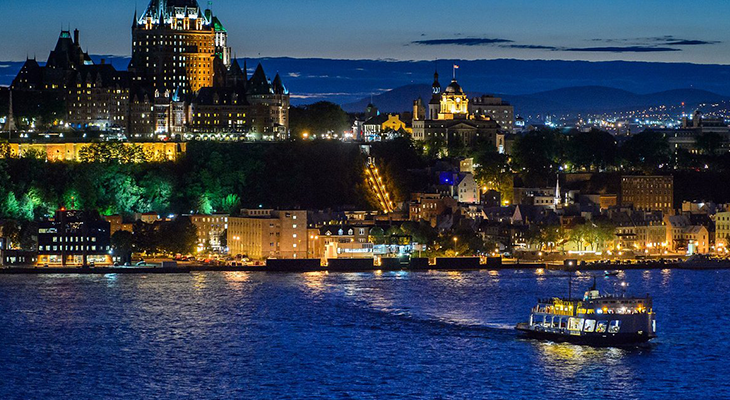Introduction: Why Old Quebec captivates travelers
Cobblestones underfoot, copper roofs above, and St. Lawrence River breezes at your back—there’s a reason Old Quebec feels like a European time capsule. Officially listed by UNESCO as the Historic District of Old Québec, the neighborhood’s fortified walls, gates, and 17th‑century streets hold 400+ years of stories—and a surprising number of modern delights. Whether you came for Dufferin Terrace views, Château Frontenac photos, the Breakneck Stairs into Petit‑Champlain, or winter’s Carnival sparkle, this guide maps the best things to do in Old Quebec City, season by season and street by street. You’ll find walkable routes, insider photo angles, museum picks, and food stops, plus practical tips on elevation changes, the funicular, and ferry vantage points. Ready to explore the only walled city north of Mexico? Lace up—Old Quebec rewards curious wanderers at every turn.
1) Why Old Quebec Belongs on Your Bucket List
UNESCO status & living history
Old Quebec’s Upper and Lower Towns together form the Historic District of Old Québec, recognized by UNESCO for its exceptional preservation of urban defenses and colonial townscape—rare in North America. You can still walk roughly 4.6 km of ramparts, pass through stone gates, and gaze over the St. Lawrence from fortified overlooks, making it one of the world’s most tangible city‑as‑museum experiences. Learn more on UNESCO.
Upper vs. Lower Town (and how to move between)
Upper Town is encircled by the walls (Frontenac, Dufferin Terrace, Parliament side); Lower Town hugs the river (Petit‑Champlain, Place Royale, Old Port). They’re linked by steep lanes and staircases—plus the Funicular if you want to save your knees. The split gives you two dramatically different vibes in just a few minutes of walking.
2) Walk the Walls: Fortifications & City Gates
If you do just one thing in Old Quebec, make it a rampart walk. The Fortifications of Québec National Historic Site preserves ~4.6 km of walls, bastions, and gates that evolved under French and British rule. The easiest sampler loop runs from Porte Saint‑Jean toward Artillery Park, across Rue des Remparts, and back via Porte Saint‑Louis—a circuit that mixes lookout points with cannons and story‑rich plaques. For deeper context, Parks Canada offers guided tours in season and maintains interpretive spaces at Artillery Park—always check for temporary restoration advisories that may reroute you. Parks Canada official page.
Timing tip: A full, leisurely wall‑and‑sites wander can take 3–4 hours depending on museum stops. Start mid‑morning for softer light and fewer crowds on the bastions; save the Rue Saint‑Jean gate view for golden hour.
Unique insight: Don’t treat the walls as a single line—think in vistas. Every 200–300 meters there’s a new angle on Frontenac, the river, and Lower Town roofs. Plan 4–5 “A/B photo frames” (foreground cannon / mid‑roof patterns / far‑river horizon) to capture images that feel uniquely yours.
3) Château Frontenac & Dufferin Terrace
There’s a reason photos of Old Quebec nearly always feature Fairmont Le Château Frontenac crowning the cliff: it’s widely considered one of the world’s most photographed hotels and a National Historic Site. Even if you’re not staying overnight, guided tours reveal the hotel’s grand‑railway heritage and architectural flourishes. Steps away, Dufferin Terrace is the city’s river‑view boardwalk—buskers in summer and adrenaline in winter. Fairmont official site | Dufferin Terrace info
From mid‑December (weather permitting), the historic 1884 toboggan slide rockets riders down at thrilling speeds; summer brings kiosks and interpretive panels revealing the Saint‑Louis Forts & Châteaux remains beneath the boardwalk. It’s also your transition point to the Governors’ Promenade and the upper entrance to the Funicular.
Unique insight: For crowd‑free Frontenac photos, shift 20–30 minutes after sunrise to the Pierre‑Dugua‑De Mons Terrace (east of Dufferin). Side‑light catches the copper roofs while most walkers are still at breakfast.
4) Petit‑Champlain, Breakneck Stairs & the Funicular
Descend the Escalier Casse‑Cou (Breakneck Stairs) into Quartier Petit‑Champlain, a postcard alley of boutiques and ateliers often cited as one of North America’s oldest commercial streets. In winter, lights and garlands add a Christmas‑market feel; in shoulder seasons, storefronts spill baskets and handmade goods onto cobbles. Artists set up nearby at Rue du Trésor, a petite open‑air gallery lane where locals sell original works. Petit‑Champlain guide | Rue du Trésor info
To glide between Upper and Lower Town, take the Funiculaire du Vieux‑Québec linking Dufferin Terrace to Rue du Petit‑Champlain. Expect short rides, steep angles, and big views of the St. Lawrence. It’s the best way to save your knees and add a fun photo moment. Funicular (official)
Unique insight: Photographers—ride down the funicular for unfolding river frames with Frontenac towering above. The descending cabin reveals new compositions every few seconds.
5) Place Royale & Notre‑Dame‑des‑Victoires
At the cobbled heart of Lower Town lies Place Royale, where Samuel de Champlain established the settlement in 1608. The square’s stone façades and Notre‑Dame‑des‑Victoires church create an intimate setting to learn how New France began—and how merchants once lived above their shops. A massive mural nearby layers 400 years of local scenes—great context before tackling the rest of Old Quebec. Place Royale | Notre‑Dame‑des‑Victoires
Unique insight: For a cinematic photo of the church, frame it through café chairs or a nearby arch; in winter, falling snow under the lamps turns the square into a film set.
6) Citadelle de Québec & the Plains of Abraham
Guarding Cap Diamant beyond the walls, the Citadelle de Québec (home of the Royal 22e Régiment) anchors the city’s military story. Pair a guided tour with a stroll across the Plains of Abraham—now an urban park where the 1759–1760 battles changed North American history. Citadelle official site | Plains of Abraham (NCC)
Inside the Plains of Abraham Museum, the permanent exhibit Battles 1759–1760 uses models, uniforms, and interactive media to explain the siege, the Battle of the Plains, and Sainte‑Foy. It’s a smart rain‑plan stop and particularly engaging for families. Museum info
Unique insight: Many visitors skim the Plains as “a big lawn.” Try a history‑plus‑picnic loop: museum → Martello Tower viewpoint → shaded allée to Cap‑Blanc stairs (or reverse). You’ll feel the terrain changes commanders once used to their advantage.
7) Museums in (and just by) Old Quebec
Musée de la civilisation (Old Port): Designed by Moshe Safdie, this river‑adjacent museum blends Québec social history with global culture in family‑friendly exhibits (Discovery Zone, rotating shows). It’s ideal to combine with a Lower Town wander. Official site
MNBAQ (nearby, on the Plains): While just beyond the walls, the Musée national des beaux‑arts du Québec is an easy add—especially if you’re already on the Plains. Expect major Québec art holdings, including Inuit and contemporary. Official site
Unique insight: Pair the museum visit with a golden‑hour ferry—both sit conveniently along the Old Port axis—then dine along Rue Saint‑Paul among antiques and galleries.
8) Seasonal Magic: Winter Carnival & German Christmas Market
Winter turns Old Quebec into a stage: Carnaval de Québec (the world’s largest winter carnival) anchors February with an ice palace, night parades, tobogganing, and the spectacle of the Ice Canoe Race battling floes on the St. Lawrence. Grab an effigy for site access, dress in layers, and plan evenings for the parades. Carnival (official)
From late November to December 23, Old Quebec’s German Christmas Market spreads across multiple illuminated sites (e.g., Place d’Armes, Place d’Youville), free to enter and heavy on mulled wine, choral sets, and wooden chalets. Visit at twilight to watch lights pop against copper roofs; bring a reusable mug. German Christmas Market (official)
Unique insight: Carnival mornings are quieter—tackle big installations early, warm up indoors at the Morrin Centre or cafés at midday, then return for night parades. Christmas Market weekdays are calmer; Thursday twilight means shorter food lines.
9) Eat, Sip, Shop: Classic Flavours & Local Makers
Old Quebec’s culinary scene blends comfort classics—think tourtière, pea soup, maple desserts—with refined Québécois tasting menus. Historic dining rooms and bistros line Rue Saint‑Louis and the lanes around Place d’Armes. For café culture, Rue Saint‑Jean and Lower Town’s Rue Saint‑Paul mix espresso with antiques browsing. Local producers and Nordic‑inspired kitchens add a modern twist. Where to Eat (Québec Cité)
For shopping, mix Petit‑Champlain’s boutiques with the Rue du Trésor art lane (original works, friendly artists). Pro tip: ship heavier items (ceramics, framed pieces) to avoid luggage juggle on the stairs.
Unique insight: Winter travelers—schedule a hot chocolate or vin chaud stop every 60–90 minutes. That cadence keeps energy high and turns the cold into cozy interludes between outdoor sights.
10) Iconic Views: Ferry to Lévis & Sunset Spots
For the single best skyline of Old Quebec, take the Québec–Lévis ferry. The 12‑minute crossing delivers sweeping angles of Château Frontenac, Dufferin Terrace, and the Upper Town skyline. Daytime departures are frequent; evenings bring reflections on the river. Fares are modest and the deck offers unobstructed photos. Ferry schedule & fares
Photo playbook: Ride to Lévis for sunset, pop up to the belvedere, then return after dusk for city‑light reflections. In winter, the sound of ice against the hull adds a soundtrack you won’t forget.
Unique insight: Compose with moving elements (a ferry railing, deck lines) to add context and stabilize hand‑held shots in low light.
11) 1‑Day & 2‑Day Micro‑Itineraries (On Foot)
1 Day: Ramparts loop → Dufferin Terrace (Frontenac photos) → Funicular → Petit‑Champlain → Place Royale (museum optional) → Musée de la civilisation → Ferry to Lévis at sunset → dinner in Upper Town near Rue Saint‑Louis.
2 Days: Day 1 above, then Day 2: Citadelle tour → Plains of Abraham Museum (Battles 1759–1760) → Morrin Centre library tour → cafés and shopping on Rue Saint‑Jean → blue‑hour ramparts walk.
Traveling with friends or a meet‑up group? Share this plan in your Trespot chat and split up museum vs. photo time, then reunite on the ferry for sunset.
12) Practicalities: When to go, mobility & language
- Best seasons: Summer for patios and promenades; December–February for the German Christmas Market and Winter Carnival.
- Mobility: Expect steep lanes and stairs; use the Funicular to ease elevation changes.
- Language: French is primary; English widely understood in visitor areas. Many tours are bilingual—verify specific times.
Quick Takeaways
- Walk a section of the ramparts for history + views you can’t get by car.
- Pair Dufferin Terrace with the ferry for day‑to‑night skyline images.
- Petit‑Champlain + Rue du Trésor deliver artisan finds and classic cobblestone vibes.
- Winter: plan for Carnival (parades, Ice Canoe Race) and the German Christmas Market.
- Add depth with Musée de la civilisation, Citadelle tours, and the Plains of Abraham Museum.
FAQs — Things to Do in Old Quebec City
Walk a section of the ramparts, photograph Château Frontenac from Dufferin Terrace, ride the Funicular into Petit‑Champlain, and finish with the ferry to Lévis at sunset for skyline views.
Yes—great for saving time/elevation and for river views. It’s a short, scenic ride between Dufferin Terrace and Petit‑Champlain. Check the official site for current hours and fares.
Expect 3–4 hours for a relaxed loop with stops, or 60–90 minutes for a shorter section. Start mid‑morning for fewer crowds and softer light.
It’s the founding square (1608) with an intimate church and stone façades that showcase the city’s beginnings—perfect for photos and context before exploring further.
Yes: Quebec Winter Carnival (parades, Ice Canoe Race) and the historic Dufferin Terrace toboggan. In December, the German Christmas Market glows across multiple Old Town sites.
Conclusion
Old Quebec is more than a checklist—it’s a layered city best enjoyed at walking speed. Start with the walls and gates to understand its shape; let Dufferin Terrace and Château Frontenac set the scene; drop into Petit‑Champlain for human‑scale charm; and stand in Place Royale to feel where it all began. Museums like the Musée de la civilisation and the Plains of Abraham Museum lend context; the Citadelle connects past to present.
Seasonality changes the script—Carnival energizes February; the German Christmas Market warms the dark with song and spice; summer breezes invite ferry crossings and terrace cafés. However you stitch it together, the most rewarding things to do in Old Quebec City are simple: walk, look up, and linger. Planning a trip with friends or a travel community? Use the micro‑itineraries here, then share your own photos and tips. When you’re ready, sync plans with your group in Trespot and go claim your favorite view—perhaps from the ferry deck at sunset, with Frontenac glowing above the river.
Join the Conversation
Was this guide helpful? Tell us which viewpoint or lane stole your heart—Dufferin Terrace, Rue du Trésor, or the ferry skyline—and why. Discovered a unique café, gallery, or photo angle? Drop it in the comments to help the travel community. If you know someone planning Old Quebec, share this guide!
Question for you: What’s your #1 tip for first‑timers tackling the hills and stairs in Old Quebec?
References
- UNESCO — Historic District of Old Québec
- Québec Cité — Explore Old Québec
- Parks Canada — Fortifications of Québec NHS
- Fairmont Le Château Frontenac — Official Site
- Québec Cité — Dufferin Terrace
- Funiculaire du Vieux‑Québec — Official
- Québec Cité — Quartier Petit‑Champlain
- Québec Cité — Rue du Trésor
- Citadelle de Québec — Official Site
- Plains of Abraham Museum — Official
We selected authoritative, official sources for attraction details, hours, and seasonal programming to support trip planning and on‑the‑ground accuracy.




